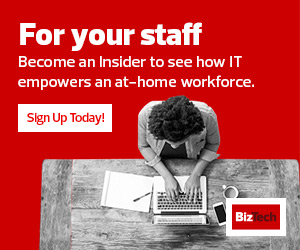The transition to remote work may be behind us, but there’s a lot of uncertainty about what work will look like in the future.
How long will employees work remotely? What will new offices look like? How will workers stay connected in a hybrid world?
Shankar Iyer, senior vice president and general manager for end-user computing at VMware, said that many employees don’t plan on returning.
“The remote work revolution is already producing many, many positive benefits,” said Iyer at VMworld 2020. “While we can talk about cost savings and the ability of employees to live wherever they want, here's another interesting effect: Three-quarters of employees say that since the wave of remote work began, employees outside of corporate headquarters feel far more empowered to make decisions.”
While there are other benefits, such as more flexibility for employees and a larger recruiting pool for businesses, many organizations weren’t set up in a way that was conducive to remote work.
“The challenge for many organizations is that, today, they're dealing with many, many siloed tools across these different categories,” said Iyer. “There is a gap that exists between what the current tools provide and what IT is trying to achieve.”
To close that gap, businesses need a way to keep employees engaged, modernize their IT and incorporate zero-trust security, according to Iyer — three elements that are built into Workspace ONE.
WATCH: Learn how empathy can be the key to an exception customer experience in the new normal.
1. Businesses Should Promote High Employee Engagement
All productivity has to start with employee buy-in. Workers need to find their tools useful, particularly when the workforce may be disconnected.
Shawn Bass, CTO for end-user computing at VMware, said that the user must now be put at the center of everything.
“We believe that employee engagement is correlated with business success,” he said. “And now, with the distributed workforce, technology plays an even bigger role in growing engagement.”
Putting everything in one place, as Workspace ONE’s Intelligent Hub does, makes it easier for workers to get what they need.
“This is where colleagues can find everything they need to be productive, with single sign-on to all types of applications, micro apps for quick tasks, communications from IT and HR, and a whole lot more,” Bass said.
Another trend that has been accelerated by remote work is the rise of BYOD in the workplace, something that VMware is accounting for with new time-based access controls.
“Many companies have frontline workers who should only be able to access certain apps during their shifts, or users and regions with regulations covering working hours,” said Bass. “With our new, time-based access controls, you'll be able to gain access to corporate resources and create policies based on shift schedule status or fixed rules.”
2. IT Modernization Can Power Businesses Into the Future
Businesses need to be able to power those employee experiences, and now that means powering access from anywhere.
“Virtual desktops, especially from the cloud, were instrumental in helping businesses adapt to the changing environment,” said Bass. He added that VMware’s Horizon 8, in addition to new features to simplify its use, now runs on more cloud platforms.
“We're continuing to add features into our cloud-based Horizon control plane, which provides universal services that help you manage all your Horizon and Horizon Cloud resources from a single location, no matter where they are,” said Bass.
The increase in devices has also created an enhanced need for simplification. Bass said that in the past year, VMware has seen the number of Windows 10 modern management deployments more than double.
“Very large deployments are now common, and we have customers with well over 100,000 fully modern, managed Windows 10 devices each,” Bass said.
“With customers supporting so many different devices in large numbers and with complex requirements, we know that unified endpoint management is just the start,” he added.
3. Implement Zero-Trust Security Principles to Protect Remote Work
Large-scale remote work has forced businesses to rethink their approach to security. For many, that means adopting zero-trust principles.
“Today, with a distributed workforce and a disappearing perimeter, organizations must make implementing a zero-trust approach their highest priority,” said Bass.
VMware has announced that multifactor authentication will soon be integrated directly into Intelligent Hub.
“This provides a modern, push-based experience for users, and if you haven't deployed MFA, this is the easiest way to get started,” Bass said.
They’ve also incorporated ways to enforce access policies and monitor risks, which are other key elements of zero trust.
“With continuous authorization and enforcement, this begins to solve what we believe are the most important challenges of maintaining security with a great user experience,” said Bass.
Follow BizTech's full VMworld coverage here.











